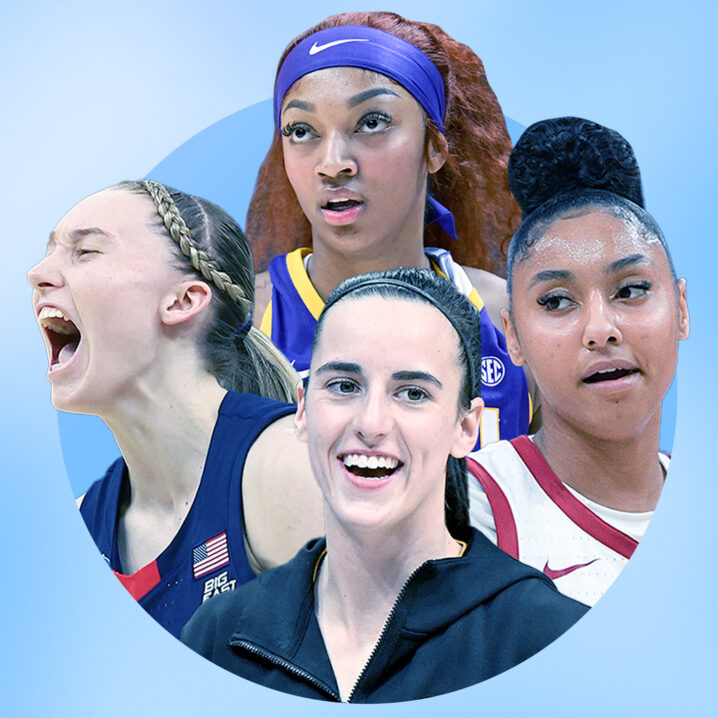
- POPSUGAR Australia
- Fitness
- This Year, March Madness Is All About the Women
This Year, March Madness Is All About the Women

Ask me to name one man competing in the NCAA’s March Madness tournament this year? I can’t . . . and honestly, that makes me proud. Because ask me to name a woman, and I can rattle off a sizable list. And I don’t think I’m the only one for whom this is the case.
It’s no secret that women’s sports receive less recognition and play than the men’s teams. And historically, coverage of women’s sports has been downright shameful – leading some fans to go as far as creating their own bars dedicated to showing only women’s games and matches.
This year, however, it seems the tide has turned. Women’s sports coverage tripled in the last five years, and the 2023 women’s March Madness tournament (aka the NCAA Division I Women’s Basketball Championship) set an attendance record with more than 350,000 fans, indicating even greater promise for the 2024 season.
Experts are already predicting this year’s women’s Final Four tournament in Cleveland will bring in more than the original $25 million estimate. “In many ways, right now, women’s college basketball is as popular if not more popular than men’s college basketball. I think Cleveland is really going to be the beneficiary of that being the case,” said David Gilbert, CEO of Greater Cleveland Sports Commission, in an interview with ABC’s News 5 Cleveland.
Don’t believe the hype? Just look to the headlines as powerhouses like Kamilla Cardoso, Caitlin Clark, Paige Bueckers, Angel Reese, Lauren Betts, and Juju Watkins continue to be spotlighted for breaking news, beating records, and challenging the stereotype that women’s sports is less entertaining than men’s.
The reckoning is here – and not only am I constantly entertained by the women athletes of today, I am in awe of their talent, grit, passion, poise, and so many other qualities that even the NCAA tried to ignore for years.
For context, it wasn’t until 2021 that the NCAA allowed the women’s basketball tournament to use “March Madness” phrasing and branding. The change came after a gender equity review was conducted and the overseeing law firm pointed out stark differences in signage, branding, and advertisement between the men’s and women’s games. In fact, the review concluded that a total of $1.5 million more had been spent on the men’s Final Four than the women’s competition.
Unfortunately, this news came as no surprise. That year, several players had posted on social media during the tournament to point out the vast discrepancies in resources being given to the men’s and women’s teams, which prompted the law firm’s review in the first place. One viral example of the inequity was the differences in the men’s and women’s weight rooms. The men were given what you’d expect to see for elite athletes competing in a major sporting event: multiple machines and racks to allow for serious training. The women, on the other hand, got a single stack of dumbbells.
Now, three years later, research is forecasting that elite women’s sports will surpass $1 billion in revenue (a 300 percent increase since 2021), and in January, the NCAA signed an eight-year deal with ESPN for $114 million a year (or $920 million total) to broadcast 19 men’s and 21 women’s collegiate sports, including national championship events in Division I women’s basketball, women’s volleyball, and women’s gymnastics.
Translation: women’s sport, and particularly basketball, is not only entertaining and worthy of the spotlight, it pays to showcase it – and well, might I add. Let’s just hope that translates to the players’ salaries in the future.
For now, I’m taking the dub and calling it: March Madness is officially for the women – the athletes, the fans, the coaches. It’s our time to shine without apology, to play without fear, to win without question that we were ever considered good enough. March Madness is for us. Period.
Alexis Jones is the senior health editor at POPSUGAR. Her areas of expertise include women’s health, mental health, racial and ethnic disparities in healthcare, diversity in wellness, and chronic conditions. Prior to joining POPSUGAR, she was the senior editor at Health magazine. Her other bylines can be found at Women’s Health, Prevention, Marie Claire, and more.

